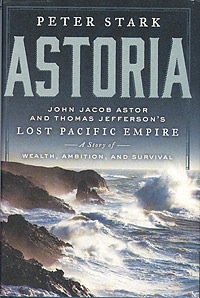
When Capt. Meriwether Lewis returned to Washington, D.C., in 1806 from his epic journey with the Corps of Discovery, he urged President Jefferson to establish a seaport on the Pacific coast to harvest the rich abundance of animal furs for international trade.
Jefferson agreed, but thought the venture best left to private enterprise. This opened the door for wealthy businessman John Jacob Astor, skilled in the business of fur trading and buying, to receive the enthusiastic backing of Jefferson and embark upon a plan to create “the largest commercial enterprise the world has ever known.”
Astor financed an overland expedition, following the route of Lewis and Clark, and a sea-going component to bring supplies and trade goods to offer the native tribes in exchange for furs. Ships loaded with fur pelts would travel to China where there was a profitable demand for them. Chinese goods would be procured and shipped to the east coast of America and Europe.
On paper, the plan was marked for success, but Peter Stark’s new book, Astoria – John Jacob Astor and Thomas Jefferson’s Lost Pacific Empire: A Story of Wealth, Ambition, and Survival, reveals that the reality of the expedition was a startling contrast to the neatly proposed venture.
In 1810, the Overland Party, led by William Price Hunt, got off to a late start, putting them in peril of winter’s hardships. Fear of being attacked by the legendary Blackfeet Indians sent them off the Lewis and Clark route into treacherous and unforgiving geography. There was an enormous miscalculation of food and water sources and starvation haunted them repeatedly.
It was a miracle that any of the travelers arrived at the mouth of the Columbia River in the winter of 1812, marking “only the second time in recorded history that a party of Americans had crossed the North American continent.”
Astor’s ship, the Tonquin, did not fare much better. Captained by a young U.S. naval hero of a belligerent and stubborn nature, the voyage was fraught with disagreements and drama. Bad weather and fear of being commandeered by a British ship (this was the War of 1812, after all) were of grave concern as well.
Of the 140 men that Astor sent to the mouth of the Columbia, more than 41 percent of them died. Astor, however, went on to accumulate incredible wealth in other business ventures – and planted his name on the community that grew up on the Oregon coast.
Stark’s remarkable telling of this largely forgotten piece of history is thoroughly enlightening. He brings the characters and the landscape to life with vivid descriptions, coming at a pace that will keep readers turning pages to find out what comes next. The instances of perilous encounters are riveting.
Missoula author William Kittredge describes Astoria as “a hard-edged beauty.” A sit-down with this book is time well spent – educational and very enjoyable.
The Montana author and journalist has written several books, including The Last Empty Spaces: A Past and Present Journey Through the Blank Spots on the American Map.
– Judy Shafter